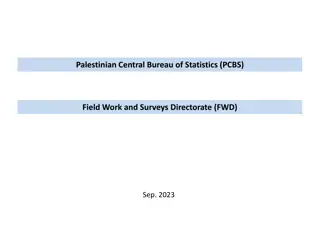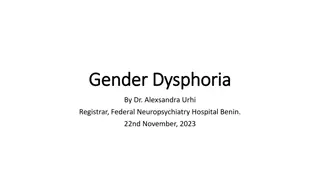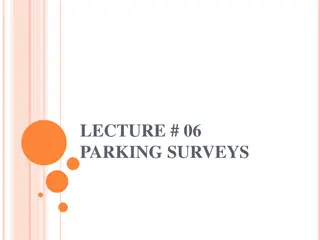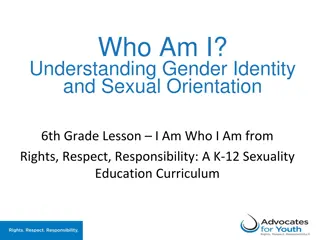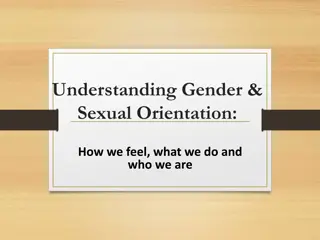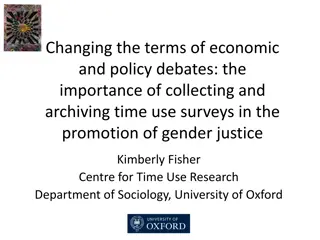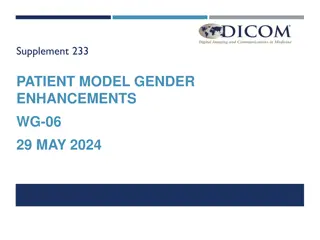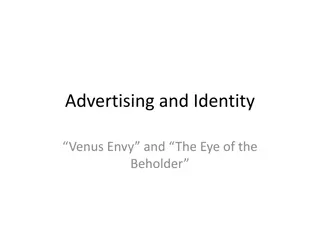Importance of Gender Identity Data Collection in Health Surveys
Gender identity data collection is crucial for identifying health disparities among marginalized groups. National Center for Health Statistics (NCHS) emphasizes the need to include questions on sexual orientation and gender identity in surveys to address health equity. Initiatives like the NCHS Health Equity CORE Goal focus on assessing gender identity accurately through various methodologies. Collaborative efforts with organizations like the Collaborating Center for Question Design and Evaluation Research (CCQDER) aim to develop measures and methodologies for better understanding gender identity in health surveys.
Download Presentation

Please find below an Image/Link to download the presentation.
The content on the website is provided AS IS for your information and personal use only. It may not be sold, licensed, or shared on other websites without obtaining consent from the author. Download presentation by click this link. If you encounter any issues during the download, it is possible that the publisher has removed the file from their server.
E N D
Presentation Transcript
National Center for Health Statistics NCHS and Gender Identity Data Collection Amy Branum Associate Director for Science NCHS
The importance of gender identity Only when questions about sexual orientation and gender identity are included in national surveys, such as those conducted by the Department of Health and Human Services, can researchers identify health disparities within or across groups who identify as lesbian, gay, bisexual, or transgender 1 1Collect Data on Sexual Orientation and Gender Identity in Health Surveys | RAND
NCHS gender identity activities NCHS Health Equity CORE Goal: By July 2023, using a range of methodologies, NCHS will identify and evaluate various question sets related to health equity, including approaches that most accurately assess gender identity. Beginning on January 1, 2022, NCHS will collect information on gender identity among sample adults in the NHIS In 2023, NHANES will also add gender identity questions First year in NHIS will be experimental, testing various question approaches SOGI Interoperability Standards: NCHS involved in discussions with others within CDC around approaches to USCDI standards Cognitive interviewing and question testing
National Center for Health Statistics Gender Identity Measure Development Kristen Miller Collaborating Center for Question Design and Evaluation Research (CCQDER)
Organization of Discussion 1. Overview of CCQDER Program 2. Gender Identity Question Design Features Data quality issues 3. CCQDER Gender Identity-Related Projects
Activities 1. Methodological Research Program Study of meaning and question response in relation to data quality Development of design and evaluation methods 2. Questionnaire Design Research Lab Question Development and Testing Projects For NCHS, CDC, HHS, and others 3. Question Evaluation Applications Q-Notes: Data entry and analysis tool for cognitive interviewing studies Q-Video: Cognitive Interview/Data Storage Q-Bank: Online library of question evaluation findings
NCHS Evaluation Methods Cognitive Interviewing Experimental Design and Embedded Probing with the Research and Development Survey (RANDS) Ethnographic Methods: In-depth interviewing, Free Lists, Card Sorts Focus Groups Interviewer Debriefing Usability Testing
Cognitive Interviewing at NCHS First cognitive laboratory, 1980s Scientific study Systematic analysis Data quality Maintenance of data Transparency Documentation Cognitive interviewing as validation Ensuring Comparability and Measurement Equity (AAPOR Webinar) Research and Development Survey (RANDS): Mixed Method
Analytic Goals of Cognitive Interviewing Studies Cognitive Testing: Conducting interviews to look for problems. Construct Validity Study: Identifying the constructs captured by individual questions by identifying the specific phenomena that account for respondents answers. Comparability Study: Determining whether constructs are consistently captured across salient respondent groups.
Research and Development Survey (RANDS) Mixed Method: Cognitive Interviewing + Web Panel Survey Data How much error? In what demographic groups? Embedded Construct and Error Probes When answering the last question, were you thinking about X, Y or Z? Experimental Design: To test different versions of questions
External Collaborations CDC coordination of data collection systems NCVHS Workgroup on SOGI & SDOH Data (ASPE) NASEM Workgroup OMB, Domestic Policy Council, State Dept FCSM SOGI Workgroup Interagency Response Error Group Community Groups
Gender Identity, Census PULSE, July 2021 SEX: What sex were you assigned at birth, on your original birth certificate? Male Female Refused Don t know GENDER: How do you describe yourself? Male Female Transgender None of these CONFIRM: Just to confirm, you were assigned {FILL} at birth and now you describe yourself as {FILL}. Is that correct? Yes No Refused Don t know
Gender Identity, Census PULSE, Week 34, 2021 Very small transgender population; no room for error Total Sample (unweighted) 64,562 Question design goal: Get everyone in the right bucket Cis-gender (M/M; F/F) 96.75% False positives = bad for understanding disparities Gender minority (M/F; F/M) .2% False negatives = bad for population estimates Selected "transgender" .3% For this data: Confirmation question false positives = 22% (corrected) Cases not corrected = ? None of these false positive/negative = ? Selected "none of these" 1.16% Missing 1.57% Percentages are weighted.
Question Design Goals Capture complexity and range of sex and gender identities Asking both SAB and Gender Mark all that apply Reduce false positive and false negative error Why is error occurring? What is the reason? Privacy = false negative; Misunderstanding = false positive Research activities: To understand the various question design features, Response categories Order Wording and phrase choices . and how they relate to performance (in allowing for complexity and generating error)
2021 NCHS Gender Identity Question Design and Evaluation Studies Cognitive interviewing NIOSH/YRBSS, ACES, NAMCS, NSVIS, NSFG 1. Constructs captured: Sex and Gender questions 2. Changing terms/understanding differences between gender minorities/non-minorities 3. Adults vs. Teens: Different interpretive processes 4. Proxy: What contexts are appropriate? Usability testing Gender X marker passport application form (for US State Dept) 100 in-depth interviews conducted Split sample with embedded probes RANDS with NISVS Questionnaire RANDS with NSFG Questionnaire
RANDS Split Sample with Embedded Probes (Experiment: Order and Gender/Sex Categories) 1. What sex were you assigned at birth, on your original birth certificate? Male 3. Just to confirm, you were assigned {FILL} at birth and describe yourself as {FILL}. Is that correct? Yes Female [Don t know] No 4. [PROBE]. You didn t answer what sex were you assigned at birth, on your original birth certificate? Can you tell us why? Select all that apply. I don t understand what the question is asking 2a. How do you describe yourself? Select all that apply. Male Female Transgender Something else: _____________ I ve never seen my birth certificate I don t want to answer this question This was a mistake, I meant to say: ___________ [text box] Other, specify: ____________ [text box] 2b. Do you describe yourself as a man, a woman, or in some other way? Select all that apply. Man Woman In some other way: _________________ [text box]
QBank: wwwn.cdc.gov/qbank Miller, K., Willson, S., Ryan, V. (2021). An Initial Cognitive Evaluation of a 2- Step Gender Identity Measure. National Center for Health Statistics - CCQDER. Hyattsville, MD https://wwwn.cdc.gov/QBank/Report. For questions, email Kristen Miller: ksmiller@cdc.gov https://www.cdc.gov/nchs/ccqder https://www.cdc.gov/nchs/rands



